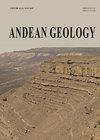中Precordilera(阿根廷)Los Baños de Talacasto剖面圣胡安组顶部Darriwilian微体化石的生物地层学和古生物地理学意义
IF 1.2
4区 地球科学
Q3 GEOLOGY
引用次数: 0
摘要
在阿根廷中部Precordillera北部的几个剖面中,人们对圣胡安组上部地层中的微化石进行了广泛的研究。相比之下,位于中部Precordillera南部的Los Baños de Talacasto剖面的同期地层缺乏生物地层和沉积学资料。本研究首次记录了牙形石与单一介形虫种的组合。Lenodus crasssus和L. pseudoplanus带的记录证实了这些地层的Darriwilian年龄,并将它们与Precordillera中部和东部几个剖面中研究的圣胡安组等效地层准确地联系起来。微相分析证实了Nuia síbirica Maslov, 1954、似球粒岩、内碎屑、蓝藻、钙质藻类和一种可能的微生物岩的存在,表明在赤道至赤道以下气候中存在浅水暖潮环境。这表明Precordillera在Darriwilian早期中期处于低纬度位置。在前科迪勒拉地区首次发现了香、张耳形牙形刺属,并对钩体耳形牙形刺标本进行了描述和图解。该属在中国北部、中亚、西藏南部、泰国西部、澳大利亚和纽芬兰的浅海环境中表现出温暖的亲缘关系,表明Precordillera与这些地区之间可能存在联系。研究剖面中介形类Pilla nodospinosa Salas的记录与前科迪勒拉中部圣胡安组顶部与拉斯阿瓜迪塔斯组下层的对比一致,并提示其与Darriwilian时代东冈瓦纳和澳大利亚地区的古生物地理联系。本文章由计算机程序翻译,如有差异,请以英文原文为准。
Biostratigraphic and paleobiogeographic significance of the Darriwilian microfossils from the top of San Juan Formation in the Los Baños de Talacasto section, Central Precordillera (Argentina)
The microfossil hosted in the strata of the upper part of the San Juan Formation has been widely studied in several sections to the northward of the Argentinian Central Precordillera. In contrast, the coeval strata at the Los Baños de Talacasto section, in the southern part of the Central Precordillera, have scarce biostratigraphic and sedimentological data. In this work, a conodont association together with single ostracod species are documented for the first time in this section. The record of the Lenodus crassus and L. pseudoplanus zones confirms the Darriwilian age for these beds and accurately correlates them with equivalent strata of the San Juan Formation studied in several sections of the Central and Eastern Precordillera. The microfacies analysis verifies the presence of Nuia síbirica Maslov, 1954, peloids, intraclasts, cyanobacteria, calcareous algae, and a possible microbialite indicating a shallow warm-water subtidal environment, in equatorial to subequatorial climate. This suggests a low latitudes position for Precordillera during the early-middle Darriwilian. The conodont genus Aurilobodus Xiang and Zhang is recognized for the first time from the Precordillera, and the Aurilobodus leptosomatus An specimens are described and illustrated. This genus shows affinities to the warm water in shallow marine environments of North China, Central Asia, South Tibet, western Thailand, Australia, and Newfoundland, suggesting probable ties between Precordillera and these regions. The record of the ostracod Pilla nodospinosa Salas in the study section would agree with the correlation of the top of San Juan Formation with the lower levels of the Las Aguaditas Formation in the Central Precordillera, and also suggests paleobiogeographic links with Eastern Gondwana and Australia regions during the Darriwilian times.
求助全文
通过发布文献求助,成功后即可免费获取论文全文。
去求助
来源期刊

Andean Geology
地学-地质学
CiteScore
3.90
自引率
0.00%
发文量
17
审稿时长
>12 weeks
期刊介绍:
This journal publishes original and review articles on geology and related sciences, in Spanish or English, in three issues a year (January, May and September). Articles or notes on major topics of broad interest in Earth Sciences dealing with the geology of South and Central America and Antarctica, and particularly of the Andes, are welcomed.
The journal is interested in publishing thematic sets of papers and accepts articles dealing with systematic Paleontology only if their main focus is the chronostratigraphical, paleoecological and/or paleogeographical importance of the taxa described therein.
 求助内容:
求助内容: 应助结果提醒方式:
应助结果提醒方式:


